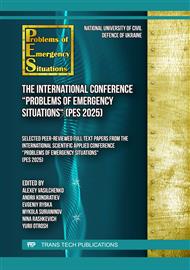[1]
Civil Protection Law of Ukraine. URL: https://zakon.rada.gov.ua/ laws/show/5403-17#Text [in Ukrainian].
Google Scholar
[2]
V. Tiutiunyk, H. Ivanets, I. Tolkunov, E. Stetsyuk, System approach for readiness assessment units of civil defense to actions at emergency situations, Naukovyi Visnyk Natsionalnoho Hirnychoho Universytetu. 1 (2018) 99–105 [in Ukrainian].
DOI: 10.29202/nvngu/2018-1/7
Google Scholar
[3]
K. Korytchenko, O. Sakun, D. Dubinin, Y. Khilko, E. Slepuzhnikov, A. Nikorchuk, I. Tsebriuk, Experimental investigation of the fire-extinguishing system with a gas-detonation charge for fluid acceleration, Eastern-European Journal of Enterprise Technologies. 3/5 (93) (2018) 47–54.
DOI: 10.15587/1729-4061.2018.134193
Google Scholar
[4]
O. Popov, D. Taraduda, V. Sobyna, D. Sokolov, M. Dement, A. Pomaza-Ponomarenko, Emergencies at Potentially Dangerous Objects Causing Atmosphere Pollution: Peculiarities of Chemically Hazardous Substances Migration, Studies in Systems, Decision and Control. 298 (2020) 151–163.
DOI: 10.1007/978-3-030-48583-2_10
Google Scholar
[5]
M. Kustov, V. Kalugin, V. Tutunik, O. Tarakhno, Physicochemical principles of the technology of modified pyrotechnic compositions to reduce the chemical pollution of the atmosphere, Voprosy Khimii i Khimicheskoi Tekhnologii. 1 (2019) 92–99.
DOI: 10.32434/0321-4095-2019-122-1-92-99
Google Scholar
[6]
A. Semko, M. Beskrovnaya, S. Vinogradov, I. Hritsina, N. Yagudina, The usage of high speed impulse liquid jets for putting out gas blowouts, Journal of Theoretical and Applied Mechanics. 3 (2017) 655–664.
Google Scholar
[7]
M. V. Kustov, O. Ie. Basmanov, O. A. Tarasenko, A. S. Melnychenko, Prohnozuvannia masshtabiv khimichnoho urazhennia za umov osadzhennia nebezpechnoi rechovyny, Problemy nadzvychainykh sytuatsii. 33 (2021) 72–83 [in Ukrainian].
Google Scholar
[8]
Ammonia. URL: https://en.wikipedia.org/wiki/ Ammonia.
Google Scholar
[9]
Chlorine. URL: https://en.wikipedia.org/wiki/ Chlorine.
Google Scholar
[10]
M. Kustov, A. Melnychenko, D. Taraduda, A. Korogodska, Research of the Chlorine Sorption Processes when its Deposition by Water Aerosol, Materials Science Forum. 1038 (2021) 361–373.
DOI: 10.4028/www.scientific.net/msf.1038.361
Google Scholar
[11]
M. Kustov, A. Melnychenko, O. Basmanov, O. Tarasenko, Modeling of Gas Sorption Process by Dispersed Liquid Flow, Materials of Science Forum. 1068 (2022) 239–247.
DOI: 10.4028/p-jdydlo
Google Scholar
[12]
A. Melnychenko, M. Kustov, O. Basmanov, O. Tarasenko, O. Bogatov, M. Kravtsov, O. Petrova, T. Pidpala, O. Karatieieva, N. Shevchuk, Devising a Procedure to Forecast the Level of Chemical Damage to the Atmosphereduring Active Deposition of Dangerous Gases, Eastern-European Journal of Enterprise Technologies. 1(10(115)) (2022) 31–40.
DOI: 10.15587/1729-4061.2022.251675
Google Scholar
[13]
M. Kustov, E. Slepuzhnikov, V. Lipovoy, I. Khmyrov, D. Firdovsi, O. Buskin, Procedure for implementation of the method of artificial deposition of radioactive substances from the atmosphere, Nuclear and Radiation Safety. 3/83 (2019) 13–25.
DOI: 10.32918/nrs.2019.3(83).02
Google Scholar
[14]
Occupants damage ammonia gas pipeline in Kharkiv region. URL: https://tsn.ua/ukrayina/u-kup-yanskomu-rayoni-okupanti-poshkodili-truboprovid-iz-amiakom-detali-2344162.html [in Ukrainian].
Google Scholar
[15]
Toxic gas at Birmingham water treatment plant sends 55 workers to hospitals. URL: https://www.al.com/news/birmingham/2019/02/multiple-ambulances-called-in-hazmat-incident-at-birmingham-water-treatment-plant.html
Google Scholar
[16]
V. Talhofer, Š. Hošková-Mayerová, Method of Selecting a Decontamination Site Deployment for Chemical Accident Consequences Elimination: Application of Multi-Criterial Analysis, ISPRS International Journal of Geo-Information. 8(4) (2019) 171.
DOI: 10.3390/ijgi8040171
Google Scholar
[17]
A. Leelossy, F. Molnar, F. Izsak, A. Havasi, I. Lagzi, R. Meszaros, Dispersion modeling of air pollutants in the atmosphere: a review, Central European Journal of Geosciences. 6 (2014) 257–278.
Google Scholar
[18]
L. Hoinaski, D. Franco, H. Lisboa, Comparison of plume lateral dispersion coefficients schemes: Effect of averaging time, Atmospheric Pollution Research. 7 (2016) 134–141.
DOI: 10.1016/j.apr.2015.08.004
Google Scholar
[19]
V. Tatarinov, U. Prus, A. Kirsanov, Decision support software for chemical accident elimination management, AIP Conference Proceedings. 2195 (2019) 020076.
DOI: 10.1063/1.5140176
Google Scholar
[20]
F. Khan, S. Rathnayaka, S. Ahmed, Methods and models in process safety and risk management: Past, present and future, Process Safety and Environmental Protection. 98 (2015) 116–147.
DOI: 10.1016/j.psep.2015.07.005
Google Scholar
[21]
M. Martínez-García, Y. Zhang, K. Suzuki, Y.D. Zhang, Deep Recurrent Entropy Adaptive Model for System Reliability Monitoring, IEEE Transactions on Industrial Informatics. 17(2) (2021) 839–848.
DOI: 10.1109/tii.2020.3007152
Google Scholar
[22]
M.V. Kustov, V.D. Kalugin, Modeling the intensity of deposition of gaseous toxic chemicals by atmospheric precipitation, East European Science Journal. 2(6) (2016) 52–59 [in Ukrainian].
Google Scholar
[23]
J. Vieceli, M. Roeselova, D.J. Tobias, Accommodation coefficients for water vapor at the air/water interface, Chemical Physics Letters. 393 1-3 (2004) 249–255.
DOI: 10.1016/j.cplett.2004.06.038
Google Scholar
[24]
P. Davidovits, C.E. Kolb, L.R. Williams and other, Mass Accommodation and Chemical Reactions at Gas−Liquid Interfaces, Chemical Reviews. 106 (4) (2006) 1323 – 1354.
DOI: 10.1021/cr040366k
Google Scholar
[25]
R. Sander, Compilation of Henry's Law Constants for Inorganic and Organic Species of Potential Importance in Environmental Chemistry, Mainz: Max-Planck Institute of Chemistry. (1999) 107.
Google Scholar


